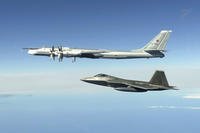The Navy's dream of building a sixth-generation manned carrier fighter could over before it even begins, 20 years before the first prototype might fly, reports Flightglobal's Dave Majumdar.
There doesn't seem to be a plausible scenario under which the Navy could afford it. In the meantime, discussions about the potential program are having one definite outcome: Making everyone else angry at the Navy. Again. Writes Majumdar:
[T]he USN is working on the F/A-XX effort by itself. Not even the US Marine Corps, with which the USN's tactical fighter force is integrated, has had any input into the F/A-XX."They once again seem to want to go it alone," the [DoD] official says, "Big mistake."
But the DoD has ordered the services to fund research and development efforts where ever possible in order to preserve the US industrial base for the future. "Considering the guidance to fund science, technology and general RDT&E accounts, I expect [the Department of the Navy] will get support for this at some level," the official says.
Retired USMC Lt Gen Emerson Gardner, a former principal deputy director of the Pentagon's Office of Cost Assessment and Program Evaluation (CAPE), says that there are lots of reasons to be sceptical about the USN's ability to fund the F/A-XX.
"It's not going to happen," Gardner says. "There's not going to be any money there."
Gardner says that the USN will probably not have any money for the programme in the fiscal year 2014 budget. Nor is it likely that the USN will ever come up with the $20 billion to $30 billion in research and development dollars to fund an F/A-XX development programme.
Not unless Congress discovers the ability to govern or the U.S. suddenly becomes flush with the profits from asteroid mining. In the meantime, however, the other jet-flying services are trying to pull the boulder called the F-35 Lightning II, and the Navy, which says it's all about boulder-pulling, is not inspiring much confidence. Majumdar's next passage spells out a belief that few people like to address openly:
The only place the money can come from is from within the F-35 programme, Gardner says. "There is a community over there that says 'let's just skip the F-35C, let's just keep buying F/A-18s and we'll go and develop this other airplane,'" he says. "That's very dangerous for the carrier because it makes the carrier irrelevant. They are not going to have first-day [of the war] capability. I'm absolutely convinced that if [the Navy does] not have stealth by the year 2022 to 2025 you will be irrelevant."Lt Gen George Trautman, a former USMC deputy commandant for aviation, concurs.
"It sort of validates the naval aviators' overall lack of commitment to the F-35," he says. "It shows how much they're in bed with Boeing to include a whole host of retired Navy aviators who work for Boeing. And it shows, frankly, their lack of commitment to unmanned systems."
Gardner concurs that the USN's relationship with Boeing is playing a role in the service's push towards a new tactical fighter programme.
"I think it's Boeing. There is a huge Boeing lobby in the Navy," Gardner says. "That has a lot to do with it."
Officially, the Navy supports the F-35C one thousand percent, and how dare you even suggest there is less than total unanimity about that! Naval Air Systems Command is careful to announce every incremental step forward of both the C and B, to keep the flow of good headlines churning. The Navy and the Marine Corps signed a deal. Everything is wonderful. Nothing to see here.
Still, NavAir also was the probable source of the slide deck a few years ago that spelled out the astronomical cost projections that eventually became the official view of the Defense Department. And there are the other ancient tensions probably still at work even now ... naval aviators are supposed to fly airplanes built by Grumman or McDonnell Douglas, not Lockheed -- Lockheed jets were for Air Force fancy boys. (Except the S-3 Viking, but c'mon, we're talking about fighters here.) More basically -- a carrier airplane with a single engine? What happens if something goes wrong in the middle of the night out over the Pacific?
Perception can be as important as reality, and despite the Navy's insistence, Majumdar's report reaffirms that there's still a belief that the Navy is, at best, only halfway pulling its share of the boulder.








